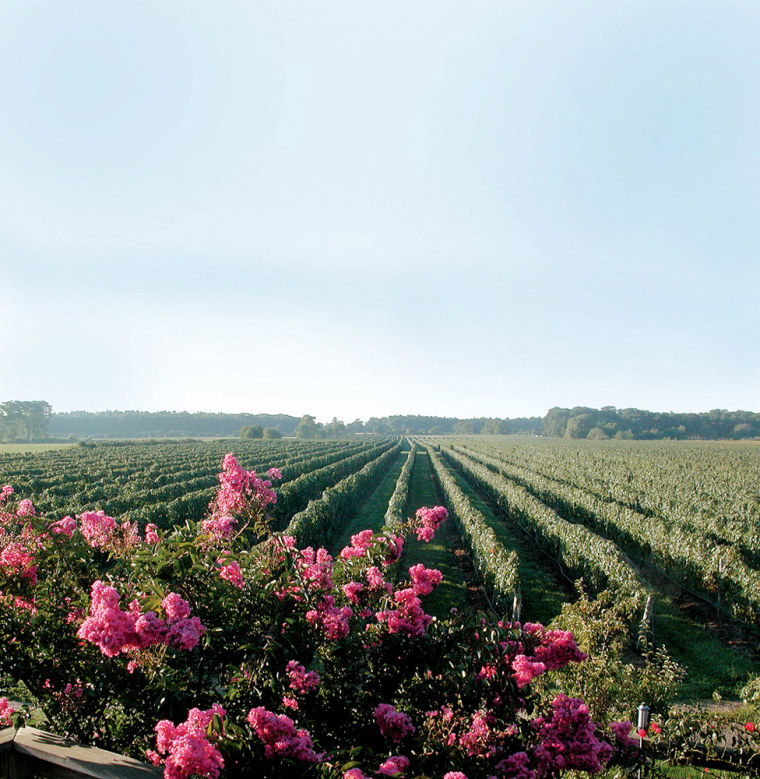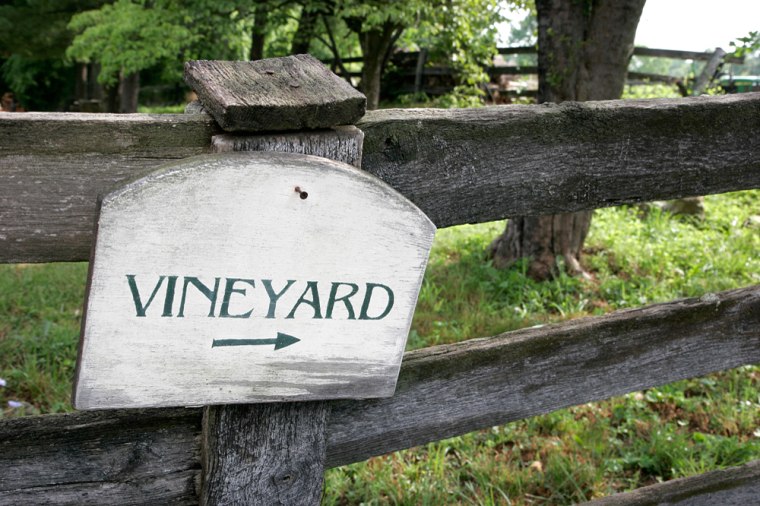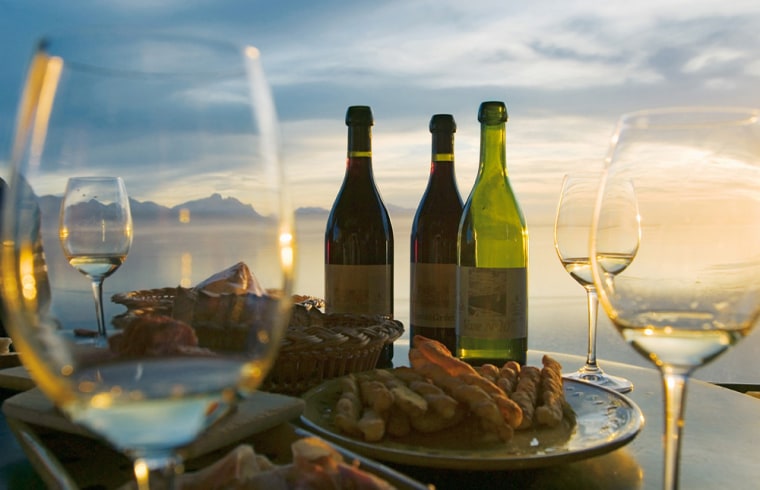While California’s Napa and Sonoma valleys have attained status rivaling that of France’s Bordeaux and Italy’s Tuscany regions, other vineyard-rich areas have quietly gone about the business of building their reputations and are emerging as serious contenders in the competition for awards and tourists. Globally, they include Switzerland and Tasmania. In the United States, they include the home of 10-gallon hats, Texas, as well as the likes of New York and ... Maryland? You read correctly.
Christine Ansbacher, a certified wine educator and author of "Secrets from The Wine Diva," likes East Coast wines so well that she talked Martha Stewart's personal chefs into featuring Italian varietals from Virginia, Maryland and Rhode Island at a wine dinner for 100 next month at Al Forno in Providence, R.I. “Emerging wine regions are more like Old World wines in that they have moderate alcohol and better acidity, so they’ll taste more lively and refreshing [than California wines]” Ansbacher says. California wines, she believes, can be “food bullies” because they tend to be heavier and more full bodied.
The Chesapeake State has teamed up with Pennsylvania to create the Mason-Dixon Wine Trail. And in Loudon County, Va., they can’t print wine guide brochures fast enough. What’s going on here ... and in Oregon, New York State, and Texas? We took a close look, region by region:
Texas
After a 21-day tour of the Bordeaux and Rhone regions of France, Susan and Ed Auler turned their Texas cattle ranch into a winery.
“We were the first ones to plant in the Hill Country in 1975,” Susan Auler says, referring to the land west of Austin. “We saw some growth early on. Soon there were three of us.” The real surge, she says, has occurred over the last five to 10 years. “The Hill Country has about 30 wineries and more coming on line all the time,” Auler says—and they’re attracting tourists. “I think our sales have been up 20 percent the last couple of years.”
The Aulers’ Fall Creek Vineyards is the third largest winery in Texas, producing 40,000 cases of 20 varietals annually. Hill Country has a proven track record with Chardonnay, Cabernet Sauvignon, and Malbec; and Fall Creek plans to make Tempranillo this year.
“We are certainly not shy people. We are can-do people,” Auler says of Texan winemakers. “We are concentrated, focused, and a convivial group of people; and perhaps that’s the best way to describe the wines.”
New York
If you think Lemberger sounds like something you’d pick up in a New York deli, you’re right if you’re talking about the liquor case. Lemberger is a red grape used to make wine in the state known more for Broadway shows and the Rockettes.

Seventy miles east of New York City are two wine trails: the North Fork and Hamptons. Since the first commercial vineyard was planted on Long Island in 1973, the number of wine producers on the peninsula has grown to 50; and while 30 percent of the acreage is planted in Merlot, Long Islanders have ventured beyond the quintessential Chardonnay to embrace lesser-known varietals such as Lemberger and Tocia Friulano.
Steven Bate, executive director of the Long Island Wine Association, says the area is garnering attention, including that of The Wine Advocate (Robert Parker), Wine Spectator, and Food & Wine, as well as British and Japanese magazines. “In 2000, we had about a half-million people that went through the tasting rooms,” Bate says. “By 2003, it was up to 940,000; and in 2006, 1.2 million people went through.”
The mid-state Finger Lakes region has a smaller, slightly younger wine industry. Celebrating its 25th anniversary in 2008, the Cayuga Wine Trail has grown from four wineries to 16. It, too, has piqued curiosity. The trail’s most popular event, spring’s Wine & Herb Festival, draws about 3,600 guests over two weekends. The region specializes in Riesling; Thirsty Owl Wine Co.’s 2006 Dry Riesling won the Governor’s Cup at the New York Wine & Food Classic in August at Copia in Napa Valley, Calif.
Virginia
The Loudoun County (Virginia) Economic Development Department had to print a second run of The Loudoun Wine Trail guide after exhausting its initial 51,000 copies of this year’s brochure. There are now 15 wineries along the trail (now accepting guests by appointment, Notaviva Vineyards will open its tasting room next summer). The oldest winery, Willowcroft Farm Vineyards, began making wine in 1981.
“Back in those days, the [state agricultural] extension service told me I couldn’t do it, but they were wrong,” says Willowcroft owner Lew Parker. “I was aware of changes in the technology of grape growing that I thought would make it possible.” Now, he says, the Loudoun wine business is “skyrocketing,” with the growth of wineries attracting more and more visitors to historic properties with views of the Blue Ridge Mountains, most within an hour of Washington, D.C.
“The jury is still out on what will be Virginia’s signature varietal,” he continues. “Cabernet Franc is being very well received.” The area’s predominant wine is Chardonnay, and Willowcroft also enjoys success with Riesling.
Oregon
It would seem logical that the warmer, southern region of Oregon should trump the northern part of the state when it comes to wine, yet Willamette Valley (particularly known for its Pinot Noirs) has received all the glory. The tables could turn, since grape growing in southern Oregon is “going like gangbusters,” according to Kim Kinderman, owner of Agate Ridge Vineyard in the Rogue Valley. “We have tripled the number of acres we have planted in the last five to six years,” she says.
Not only are the number of wineries proliferating, but also the range of varietals is expanding, particularly with later-ripening grapes. Kinderman, who counts 36 wineries in the four-valley area (all within an hour of each other), says Rhone varietals do particularly well there. And the word is getting out. A wine writer from D.C. Examiner published two articles on the region after a visit this summer.
The oldest winery, Hillcrest Vineyard, dates back to 1961. Agate planted its first vineyards in 2001 and opened its tasting room this year. Most of the wineries are young and still small, so if you want to buy a bottle of southern Oregon wine (particularly if you don’t live in Oregon), you’ll probably have to visit the wineries.
Tasmania, Australia
Farther afield, where the Pacific Ocean rips a notch into the northern coast of Tasmania, blue and yellow signs guide travelers along the 105-mile circular Tamar Valley Wine Route.
“There were two vineyards planted in the 1960s, which are still in full swing today,” says Mary Wilson, owner with husband Micheal of Velo Wines. “The first was named La Provence, now Providence Vineyard at Lillydale (this is Tasmania’s oldest vineyard), and Chateaux Legana, now Velo Wines.” (Velo gets its name from Micheal Wilson, Tasmania’s only Tour de France cyclist.) The region’s wineries—now up to 21—are noted for Pinot Noir and sparkling wines, though they also produce Chardonnay, Riesling, Sauvignon Blanc, Gewürztraminer, Pinot Gris, Cabernet Sauvignon, and Merlot.
Switzerland
Lavaux, Switzerland, celebrated its recent designation as a UNESCO World Heritage site in September by throwing a festival showcasing its wine appellations. “Chasselas is ubiquitous; and with their concentration on this one white grape to the exclusion of all others, Vaudois vignerons—particularly those at Dézaley, St. Saphorin, and Epesses—produce some of the best Swiss wines,” says Maja Gartmann of Switzerland Tourism. “And low-priced Gamays have recently taken on imported French Beaujolais with some success.” Pinot noir is another specialty of the region.

What makes the shores of Lake Geneva particularly attractive—in addition to the backdrop of the Alps—is that you can follow a foot trail through the vineyards. Granted it’s a healthy walk (20 miles), but what better way to spend a day? For those less inclined to hoof it, there are trains, including the Lavaux Express, a mini train similar to one you find in a theme park. No freight-hopping experience necessary: Le Petit Train des Caveaux stops at cellar doors during its two-hour ride (why else would they give you a souvenir glass?).
Maryland
“Tobacco farming is effectively dead, and there is a lot of land looking for something to do,” says Rob Deford, owner of Boordy Winery in Hyde, Md., about 15 miles north of Baltimore. After a state buyout program in 1998, many tobacco farmers turned to viticulture. But a deficit of local grapes exists (with 1.5 tons imported for every ton grown in Maryland) “because the [wine] industry is growing so fast,” says Deford, who was a produce farmer before being recruited to grow grapes for Boordy and who purchased the winery in 1980 after studying viticulture at University of California-Davis.
“We were the first winery in the state and one of the first in the East, post-Prohibition,” Deford says. Now Boordy is one of eight wineries on the Mason-Dixon Wine Trail—a two-state collaboration that Deford says makes a point of maintaining an equal number of wineries in Maryland and Pennsylvania, all within a 20-minute drive of each other. It is one of nine wine trails identified by the Maryland Wineries Association.
Although he now sees about 50,000 tasting-room guests in a year, Deford caters to a single-state market. “That’s where the pride factor is working in your favor; and Maryland, fortunately, is a thirsty state,” he says. He’s most proud of his winery’s Cabernet Franc and a blend called Rockfish (named after the state fish) made with Seyval Blanc, Vidal Blanc, and Chardonnay. Grapes that do best in Maryland are Cabernet Sauvignon, Cabernet Franc, Merlot, Petit Verdot, Chardonnay, Pinot Grigio, Sauvignon Blanc, and Vidal Blanc.
Boordy has more than tripled production in the last six years, and Deford is excited to see other wine-producing regions besides the usual suspects in the press.
“I’m pleased to see that slowly but surely the outback is gaining attention.”
